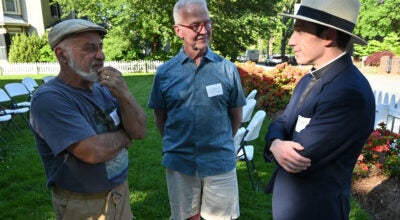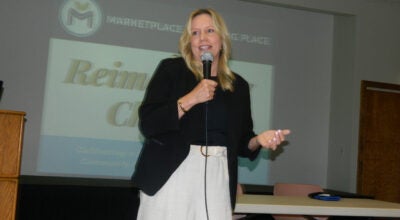Published 12:00 am Thursday, February 21, 2013
SALISBURY — They arrive about 12:30 p.m., before the first Rotarians come straggling in.
The women — usually 14 in number — say quick hellos to each other, sign in for their tables, clip on name tags and make sure the stations along the wall have pitchers of iced tea and water.
There are no uniforms, no gloves, just comfortable clothing. This wait staff — members of the Charity League of Salisbury — handles things much like it was done 90 years ago when the group had a different name but similar mission.
By the time Rotarians finish a verse of “America,” the Pledge of Allegiance and an invocation, the women’s serving of the tables is in full swing.
They move quickly between the kitchen in back and the tables, carrying bowls of Debbie Suggs’ country-style cooking. On this particular Tuesday, the menu includes chicken, mashed potatoes, beans, hot rolls and dessert.
With a family-style flair, the Rotarians pass around the food at each of their tables. After all the nourishment is delivered, the women make sure the Rotarians have plenty of water or tea.
Only sweet tea is served at Rotary.
Traditions die hard in Salisbury. The Rotary Club here is the third oldest in North Carolina, and it’s the only one — no one has stepped forward to contest this — where every Tuesday women volunteers wait on club members hand and foot.
“It wouldn’t be Salisbury Rotary without the women who have done it for years,” longtime Rotarian Ed Clement says. “They are part of the club.”
Rotary Club President Carl Repsher says the Charity League, whose deep origins go back to 1887, “is a very special part for us.”
“It’s unique, a product of some history,” Repsher adds. “… It’s quite special.”
ggg
What the Charity League women do is part Southern charm, part Downton Abbey.
As the Rotarians finish their meal and settle back for their weekly program, the women are clearing the food and many of the dishes.
They carry things back to Suggs and her two-woman crew. Meanwhile, the Charity League women also set up two tables in the kitchen, close the doors and have their own meal and quality time to socialize.
“I just love going there because I love the girls,” says Virginia Krotchko, who has been waiting on Rotarians for at least 15 years. “… That’s just a fun time. There have been times when we have to be careful (because) we laugh so hard.”
ggg
The Charity League has teams available for each Tuesday of a month, even a fifth Tuesday when that comes around on the calendar.
In all, 45 women belong to teams or on a call list as substitutes.
Most of the women are retirees; the oldest now is Libby Hollowell, who is 91. Joyce Ingram is currently the longest serving, with 26 consecutive years.
Many of the women serve multiple Tuesdays — a hard-core group often waits tables on the first, third and fourth Tuesdays, for example.
“The men seem to appreciate the service we give them,” says Helen Hager, who can’t remember when she started. She usually waits on Table 11.
Hager likes the social time with the other women, and “there’s a good fellowship with the men, too,” she says.
It should be noted there also are some women Rotarians.
ggg
Both the women wait staff and the Rotarians tend to go to the same tables every Tuesday. It’s a lot like church and the way congregational members sit in the same pews on Sundays.
When Judy Moore joined the league seven or eight years ago, she told her team leaders, “Just put me wherever you want me.”
She considers herself “kind of a floater,” but now you’ll usually find her serving tables 9 or 10.
Moore says something you hear repeatedly from the Charity League women:
“It’s something I look forward to and not something I dread. I enjoy it.”
Over almost a century of putting in countless hours of service time to Rotarians, the Charity League women also have helped countless people in need.
ggg
The Rev. Jethro Rumple urged the young women of First Presbyterian Church to form a group to help the needy, and 11 women held their first meeting Feb. 11, 1887.
But what to name themselves?
In 1886, Margaret McDonald Bottoms, a methodist minister’s wife, had formed a group in New York City called the King’s Daughters and Sons.
Attracted by the name “King’s Daughters,” the Salisbury group affiliated with the national and international organizations.
The organization grew rapidly. By the time of a state convention in 1902, leaders decided to divide the groups into circles, and Salisbury’s organization became known as the Relief Circle of the King’s Daughters.
According to a history pieced together by Robbie Ladd, using sources such as Jo White Linn’s history of First Presbyterian Church, being a member of the King’s Daughters “was long considered an entree into Salisbury society.”
“So efficiently did the ladies minister,” Ladd writes, “that no one knew which student nurse, senior citizen or college student was being sponsored by the Relief Circle.”
The women quietly raised money for the poor and paid hospital bills for those who could not afford care.
Ladd says the King’s Daughters “investigated home situations undesirable for young women and, when needed, paid for their board and education at nearby colleges.”
Beyond helping individuals, the King’s Daughters made financial contributions to hospitals, orphanages, training schools, senior homes, nursing schools, Traveler’s Aid and the American Bible Society.
“And wherever a need was brought to their attention,” Ladd says.
To raise money, the women put on talent shows, and sponsored bazaars, white sales, lawn parties, luncheons and suppers.
“It should be noted,” Ladd writes, “that many of the members of the King’s Daughters had household help. This allowed them more time to spend on community activities.”
One of the King’s Daughters’ biggest successes was its 1912 publication of “The Gem City Cookbook,” reprinted in 1920, the year the Salisbury Rotary Club was established.
ggg
In 1920, the Presbyterian Church built what was called “The Hut” behind the church to accommodate Sunday School classes and other group meetings, including the King’s Daughters.
The women used the hut for serving luncheons and other special meals to civic organizations, including the newly formed Rotary.
Over the next 15 years or so, the King’s Daughters saw its group becoming increasingly interdenominational, and members also wanted a more modern kitchen and dining area to meet their needs.
The women borrowed $5,000, broke ground in April 1938 on a new “Hut” on Liberty Street, and within six weeks, the Rotarians were served their first lunch in the new building.
The lunch venue has not changed in 75 years.
ggg
According to Dec. 11, 1962, minutes, the State Board of the King’s Daughters objected to the Rotary Club’s sign’s being attached to the women’s Salisbury hut.
With their allegiance strongly tied to the Rotarians, the local daughters decided to withdraw from the state organization rather than take down the Rotary Club’s sign.
So the name was changed again — this time to the Relief Circle of Salisbury.
By the 1970s, the Relief Circle was losing members to newer organizations. Ladd says the circle considered leasing the Hut to a restaurant, which could in turn rent the building for meetings or for catering to large groups.
But the ever-loyal Rotarians learned of these discussions, conducted their own investigation and offered to purchase the Hut so it would continue as the club’s meeting place.
Clement, then a young member of the club, participated in that transaction. He says the women would have gladly donated the Hut to Rotary.
“Of course, they gave the money to the community,” he says.
In 1971, the Rotary Club paid $22,000, and that sum was deposited in the Relief Circle of Salisbury account, where $20,000 of the original payment remains today.
Ladd says the interest off that fund, plus the monthly payments provided by Rotarians for the women’s luncheon service are used toward charitable giving each year.
The club and Charity League also have a Tuesday-before-Christmas tradition in which only soup and sometimes a sandwich are served. At that meeting, the Rotarians leave cash and checks — additional funds the Charity League gives to its causes.
After their purchase of the Hut, Rotarians made sure the Relief Circle kept serving them lunch.
“This new arrangement worked well for everyone,” Ladd says.
In 1994 or 1995 — the exact year is not known — Relief Circle members changed their name to the Charity League of Salisbury.
ggg
For some 40 years, Tankie Embrey waited on Table 4 at Rotary.
“I lived for Tuesday, I loved it,” she says. “It was really an inspiring time for me. I cried for days after I had to retire.”
Embrey served long enough for her 90th birthday to be celebrated at a Rotary Club meeting. Her son was visiting from Indonesia that same day.
“It was a very memorable occasion,” she says.
Among the Charity League women, Embrey belongs in a hall of fame, along with women such as Charlotte Taylor and Frances McNeely. There re others, of course.
One of Embrey’s friends, Judy Moore, keeps returning to the good feeling she, Embrey, Taylor and most of the other Charity Leaguers have had after serving the Rotarians.
“It makes us want to be better because they give us these kind words,” Moore says.
Retired City Manager David Treme, a loyal Rotarian, pays back the compliment:
“They’re class,” he says.
Contact Mark Wineka at 704-797-4263,or mwineka@salisburypost.com.





